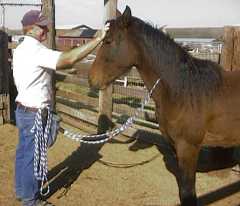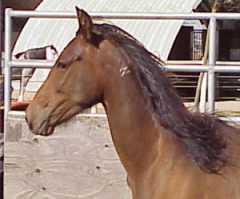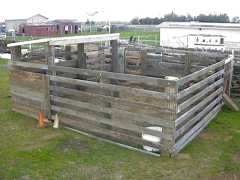"Gentling Wild Horses-
|

|
| Folks that gentle wild horses for the first time often have a number of concerns and questions. While we've put up literally hundreds of documents on horse behavior, gentling and training in the KBR Training Section, it can all get a bit overwhelming. Wild Horse 101 is a basic step-by-step description of the process that we use and recommend. Links are provided as you proceed through this feature so you can go to more in-depth explanations of the equipment and approaches illustrated. |
| OUR CASE STUDY HORSE |
|
The case study horse for this feature is Lucky, a 2 year old State of Nevada estray believed to be a survivor from the Virginia Range in Nevada where horses are often harassed by humans and 34 horses were killed for sport. He arrived with
a mortal fear of humans, displaying extreme fright at just the scent of people and becoming self-destructive, violently crashing the fences when approached.
Lucky displayed virtually all of the characteristics of an adopter's worst case scenario. Confinement and conventional round pen approaches would not work on this horse. The methods we will show that worked on Lucky can work on virtually any adopted wild horse. |
Note his guarded body language;
|
| PROPER WORKING FACILITIES |
|
Whether one uses a round pen or a square pen is usually not critically important. What is important is that the pen is properly constructed, tall enough for the wild horse not to attempt to jump it, heavy enough in construction that the horse
won't damage it or go through it if he crashes against it, and preferably with any open spaces reinforced with heavy "no climb" type woven wire (not welded wire) so that the horse can't get a hoof or leg through it. We don't try to incite a horse to crash a fence, but mistakes do happen and sometimes a reaction can be triggered by things happening outside the pen.
Our Quick and Easy Mustang Pen uses 2x6 lumber lag bolted to telephone poles. Heavy woven wire sandwiched between the poles and side rails prevents a hoof from going through. The spacing of the rails allows the horse some outside visibility without overstimulating him. (Properly built 6 foot pipe corrals are also suitable.) |
This pen was constructed mostly
|
| FUNDAMENTAL TRAINING CONCEPTS |
|
There are a few basic concepts that an adopter needs to employ in order to reliably gentle a wild horse. They include:
We can impose ourselves on the horse and force him to submit, with all the attendant hazards and obstacles that come with that approach. Or we can spend a little time focusing on security, bonding and leadership and create a horse that is willing to learn. This feature describes some approaches that we have found to develop security, bonding and leadership and create horses that will socially interact with their adopters and are interested in learning.
When a horse is in "self preservation" mode, he is operating primarily on his right brain hemisphere ("flight or fight" instinct) and can't learn much. If we can stimulate his curiosity, he will use his left brain hemisphere which is his thinking and learning apparatus. Fortunately for us horses don't efficiently use both hemispheres at the same time, flipping from one mode to another, so if we can keep his thinking side active, he'll be less likely to panic or become violent. The handler must always remember, however, that the horse can flip from thinking mode to self-preservation mode in an instant! Anyone inside the pen should remain attentive and continuously "read" the horse until the horse's self confidence has reached the point that he can accept human activities close by. In Part Two of this feature we will discuss our initial approaches when we enter the pen. Continue to Part TwoPress "Back" to return to the page which brought you hereReturn to KBR Training SectionReturn to KBR World of Wild Horses & BurrosReturn to LRTC Wild Horse MentorsGo To
|


